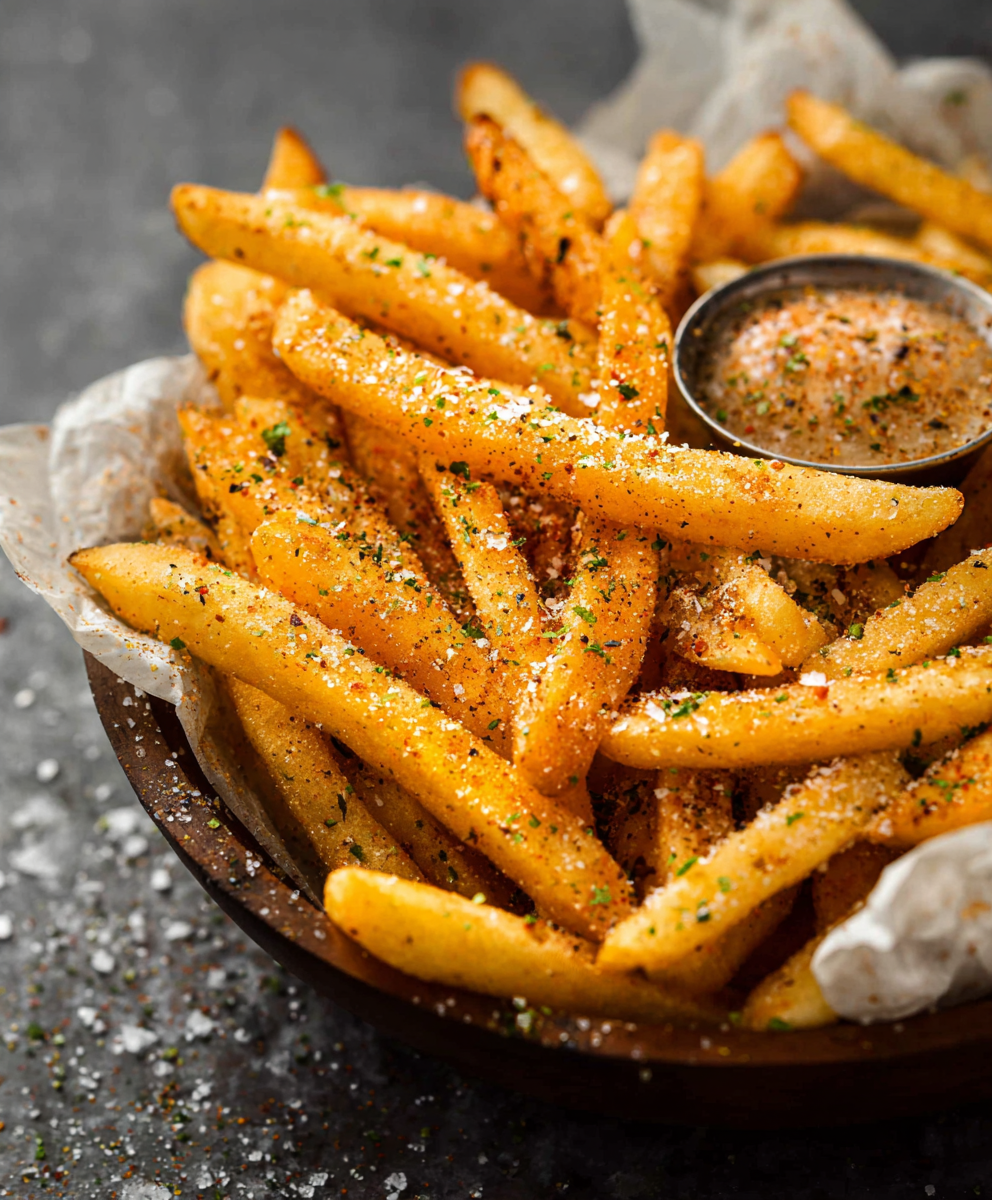Introduction
Who doesn’t love crispy, golden French fries fresh out of the fryer or oven? But let’s be honest—plain fries can feel incomplete without the right flavor kick. That’s where Homemade French Fry Seasoning comes in. Think of it as the magic dust that transforms ordinary fries into unforgettable, mouthwatering bites.
In this guide, we’ll explore a simple recipe using pantry staples, dive deep into why each ingredient matters, and uncover tips for storing, customizing, and using your seasoning blend. Whether you’re making classic shoestring fries, thick wedges, or even baked sweet potato fries, this seasoning will become your go-to secret weapon in the kitchen.
1. Why Make Homemade French Fry Seasoning?
Store-bought seasonings often come with hidden additives, preservatives, or too much sodium. By making your own Homemade French Fry Seasoning, you’re in full control. It’s fresher, customizable, and honestly, more fun. Imagine sprinkling a flavorful blend you created yourself—kind of like putting your personal signature on every batch of fries.
2. The Simple Ingredients You’ll Need
Here’s the exact recipe:
Ingredients
1 tablespoon paprika
1 tablespoon garlic powder
1 tablespoon onion powder
1 tablespoon salt
1 teaspoon black pepper
1 teaspoon dried oregano
1 teaspoon dried thyme
1/2 teaspoon cayenne pepper (optional)
These ingredients are likely already in your pantry, making it both convenient and budget-friendly.
3. Step-by-Step Directions
Directions
In a small bowl, combine paprika, garlic powder, onion powder, salt, black pepper, dried oregano, dried thyme, and cayenne pepper (if using).
Mix until all the ingredients are well combined.
Store the seasoning blend in an airtight container.
Sprinkle generously over freshly cooked French fries.
Toss to coat evenly.
Enjoy your perfectly seasoned French fries!
4. Ingredient Breakdown and Flavor Roles
Paprika: Adds mild smokiness and a beautiful red color.
Garlic powder: Brings depth and savory warmth.
Onion powder: Enhances flavor with a subtle sweetness.
Salt: The key enhancer that makes everything pop.
Black pepper: Adds a mild kick.
Dried oregano: Brings an herby Mediterranean vibe.
Dried thyme: Adds earthy, woodsy undertones.
Cayenne pepper: Optional, but great for heat lovers.
Each ingredient works like a musician in an orchestra—together, they create harmony.
5. Tips for Mixing and Storing Seasoning
Use a whisk for even blending.
Store in a glass jar with a tight lid.
Keep away from light and moisture.
Shelf life: up to 6 months.
Think of your seasoning like ground coffee—it stays potent longer when stored properly.
6. How to Use Homemade French Fry Seasoning
While sprinkling over fries is the classic way, you can also:
Mix with olive oil before tossing fries for deeper flavor.
Add to potato wedges before baking.
Use on frozen fries to instantly upgrade them.
7. Best Types of Fries to Use with the Seasoning
Shoestring fries: Perfect for a light dusting.
Curly fries: Seasoning clings beautifully to the ridges.
Steak fries: Need a generous coating to balance their thickness.
Sweet potato fries: The seasoning’s savoriness balances the natural sweetness.
8. Variations and Customizations
Want to make it your own? Try:
Adding smoked paprika for stronger smokiness.
Swapping thyme for rosemary.
Mixing in Parmesan powder for cheesy fries.
Using chili powder for Tex-Mex flair.
9. Healthier Alternatives and Adjustments
Reduce salt for a low-sodium version.
Replace paprika with turmeric for anti-inflammatory benefits.
Use pink Himalayan salt for added minerals.
Skip cayenne for a kid-friendly blend.
10. Common Mistakes to Avoid
Over-salting: Fries are already salted, so balance is key.
Adding seasoning too early: Always sprinkle after frying or baking to avoid sogginess.
Not mixing evenly: Clumps mean uneven flavor.
11. Serving Ideas Beyond Fries
This seasoning isn’t just for fries! Try it on:
Popcorn
Roasted veggies
Grilled chicken
Scrambled eggs
It’s a versatile blend you’ll reach for often.
12. Pairing Dips and Sauces
Seasoned fries deserve great partners:
Classic ketchup
Garlic aioli
Ranch dressing
Spicy sriracha mayo
Honey mustard
Think of seasoning as the outfit and dips as accessories—they complete the look.
13. Storing Cooked Seasoned Fries
If you have leftovers:
Cool completely before storing.
Keep in an airtight container in the fridge.
Reheat in the oven or air fryer to restore crispiness.
Avoid microwaving—no one likes soggy fries.
14. Why This Recipe Beats Store-Bought Mixes
Homemade seasoning wins because:
No preservatives.
Fully customizable.
Costs less over time.
Tastes fresher and more balanced.
It’s like the difference between a fast-food burger and one you make at home—both fill you up, but one clearly feels more special.
15. Conclusion and Final Thoughts
Making your own Homemade French Fry Seasoning is a game-changer. With just a few simple ingredients, you can turn plain fries into a restaurant-worthy side dish. Plus, it’s healthier, customizable, and versatile enough to use beyond fries. Once you try this recipe, you’ll never look back at plain or store-bought fries again.
So, next time you whip up a batch, grab your seasoning jar and sprinkle generously—you deserve fries that taste unforgettable!
FAQs
1. Can I make Homemade French Fry Seasoning without salt?
Yes! Simply skip the salt or replace it with a salt substitute for a low-sodium version.
2. How long does Homemade French Fry Seasoning last?
If stored in an airtight container in a cool, dry place, it can last up to 6 months.
3. Can I use fresh herbs instead of dried ones?
Dried herbs work best for storage, but you can use fresh herbs if making a small batch to use immediately.
4. Can I use this seasoning on frozen fries?
Absolutely! Sprinkle the seasoning on hot, cooked frozen fries for instant flavor.
5. What other dishes can I use Homemade French Fry Seasoning on?
It’s great on popcorn, roasted veggies, chicken, eggs, and even grilled seafood.







